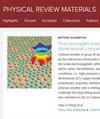在氧化镁(110)基底上生长的 Co/Pt 双层膜中的巨界面面内磁各向异性
IF 3.4
3区 材料科学
Q2 MATERIALS SCIENCE, MULTIDISCIPLINARY
引用次数: 0
摘要
强磁各向异性对自旋电子器件至关重要,但与垂直磁各向异性(PMA)相比,面内各向异性(IMA)的强度限制了它在磁存储设备中的应用。在我们的研究中,我们在 Co/Pt(110) 双层膜中观察到了巨大的界面单轴 IMA,它大约是 Co/Pt(111) 系统中 PMA 的五倍。通过添加另一个界面以形成 Pt/Co/Pt 三层膜,总的界面单轴 IMA 可以进一步提高到 13.1±0.3erg/cm2 ,使其成为一个很有前途的高密度存储设备平台。Co/Pt(110) 双层膜中的界面 IMA 与界面上的 Co 有关,可以通过插入超薄铜层来控制。我们的研究结果表明,Co/Pt(110) 系统具有很强的面内各向异性,使其成为研究强各向异性系统中自旋电子现象的理想平台。本文章由计算机程序翻译,如有差异,请以英文原文为准。

Giant interfacial in-plane magnetic anisotropy in Co/Pt bilayers grown on MgO(110) substrates
Strong magnetic anisotropy is crucial for spintronic devices, but the strength of in-plane anisotropy (IMA) has constrained its applications in magnetic storage devices in contrast with the perpendicular magnetic anisotropy (PMA). In our study, we observed a giant interfacial uniaxial IMA in Co/Pt(110) bilayers that is approximately five times larger than the PMA in Co/Pt(111) systems. By adding another interface to form Pt/Co/Pt trilayers, the total interfacial uniaxial IMA can be further enhanced to , making it a promising platform for high-density storage devices. The interfacial IMA in Co/Pt(110) bilayers is related to the Co at the interface and can be controlled by inserting an ultrathin Cu layer. Our results demonstrated the strong in-plane anisotropy in Co/Pt(110) systems, making it a promising platform for studying the spintronic phenomenon in strongly anisotropic systems.
求助全文
通过发布文献求助,成功后即可免费获取论文全文。
去求助
来源期刊

Physical Review Materials
Physics and Astronomy-Physics and Astronomy (miscellaneous)
CiteScore
5.80
自引率
5.90%
发文量
611
期刊介绍:
Physical Review Materials is a new broad-scope international journal for the multidisciplinary community engaged in research on materials. It is intended to fill a gap in the family of existing Physical Review journals that publish materials research. This field has grown rapidly in recent years and is increasingly being carried out in a way that transcends conventional subject boundaries. The journal was created to provide a common publication and reference source to the expanding community of physicists, materials scientists, chemists, engineers, and researchers in related disciplines that carry out high-quality original research in materials. It will share the same commitment to the high quality expected of all APS publications.
 求助内容:
求助内容: 应助结果提醒方式:
应助结果提醒方式:


